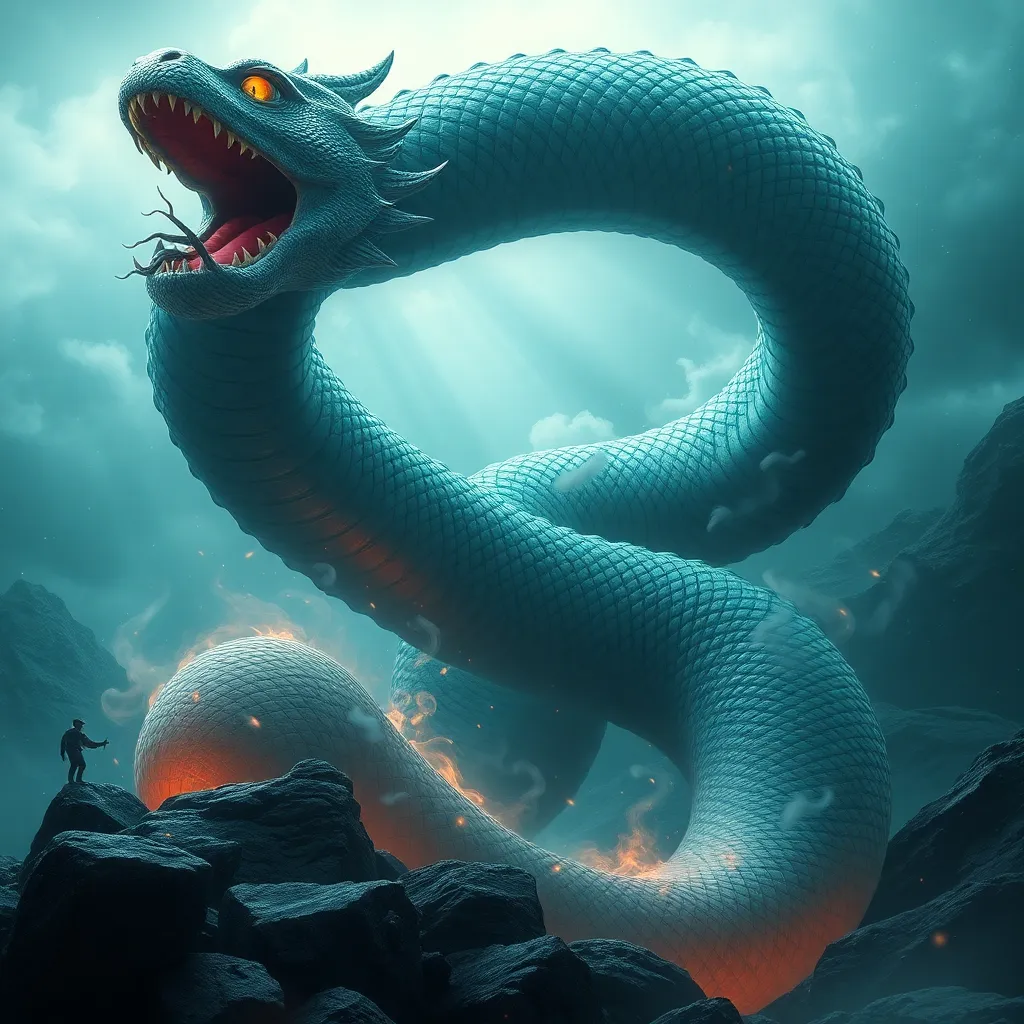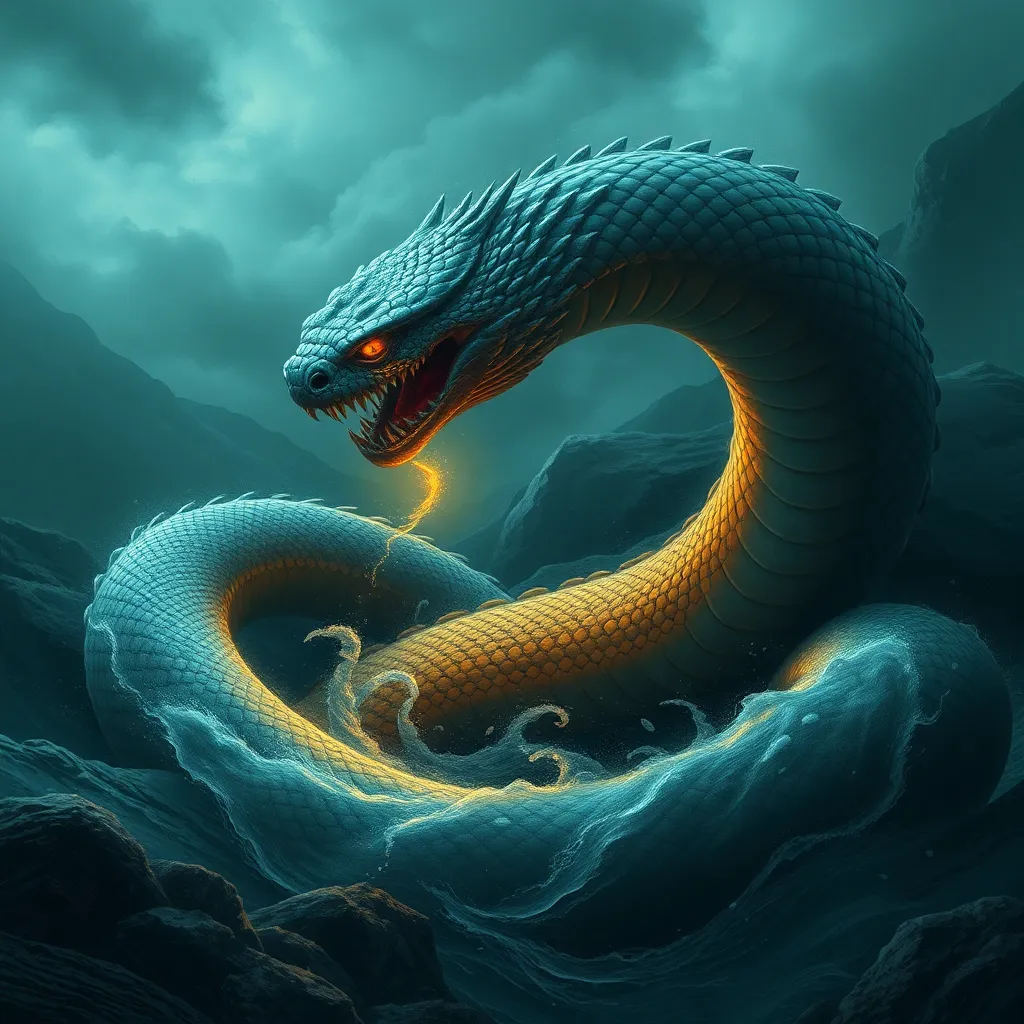Jörmungandr’s Prophecy: The Serpent’s Foretold Impact on the World
I. Introduction to Jörmungandr
In the rich tapestry of Norse mythology, few figures are as formidable and enigmatic as Jörmungandr, the World Serpent. This colossal creature, known for encircling the Earth and biting its own tail, embodies the intricate connections between fate, chaos, and the natural world. Jörmungandr’s significance extends beyond mere folklore; it is deeply rooted in the mythological framework that shapes the narratives of gods and heroes. This article aims to explore Jörmungandr’s prophecy and its implications for both the mythological realm and our understanding of existence.
II. The Origins of Jörmungandr
A. Birth and lineage: Loki and the Giants
Jörmungandr is the offspring of the trickster god Loki and the giantess Angerboda. According to Norse mythology, Loki’s union with Angerboda produced not only Jörmungandr but also Fenrir, the great wolf, and Hel, the ruler of the underworld. This lineage places Jörmungandr in direct opposition to the Aesir gods, marking him as a significant figure in the ongoing struggle between order and chaos.
B. Jörmungandr’s role within the pantheon of Norse gods
Within the pantheon of Norse deities, Jörmungandr is often seen as a representation of the chaotic forces of nature. His existence serves as a reminder of the delicate balance between creation and destruction, a theme that resonates throughout the myths of the Norse world. His arch-nemesis, Thor, embodies the forces of order and protection, setting the stage for their inevitable confrontation.
C. Symbolism of the serpent in ancient cultures
The serpent has long been a potent symbol in various ancient cultures, often representing duality, transformation, and the cycle of life and death. In many traditions, serpents are seen as guardians of wisdom and knowledge, while also embodying danger and chaos. Jörmungandr’s representation as a serpent encapsulates these themes, highlighting the intricate relationship between humanity and the natural world.
III. The Prophecy of Ragnarök
A. Definition and importance of Ragnarök in Norse mythology
Ragnarök, often referred to as the “Twilight of the Gods,” is a series of events that signal the end of the world in Norse mythology. This cataclysmic battle between the Aesir gods and the forces of chaos leads to the death of many deities, including Odin and Thor, as well as the destruction of the Earth itself. Jörmungandr plays a pivotal role in this prophecy, as his actions and fate are intertwined with the destiny of the cosmos.
B. Jörmungandr’s foretold battles and significance during Ragnarök
During Ragnarök, Jörmungandr is prophesied to rise from the ocean, unleashing chaos as he confronts Thor in a fierce battle. This clash is significant not only for the fate of the gods but also for the symbolic representation of man’s struggle against the uncontrollable forces of nature. The two titans are fated to slay one another, highlighting the inevitability of fate and the cyclical nature of existence.
C. The prophecy’s implications for gods, humans, and the world
The implications of Jörmungandr’s prophecy extend beyond the mythological realm; they resonate with human experiences of struggle, loss, and renewal. The prophecy serves as a reminder of the fragility of existence and the ultimate inevitability of change. As the world is consumed by fire and water, a new cycle begins, symbolizing rebirth and transformation.
IV. Jörmungandr’s Influence on Nature and the Cosmos
A. The serpent as a representation of the ocean and its depths
Jörmungandr is often associated with the vastness of the ocean, embodying its mysteries and dangers. His position encircling the Earth serves as a metaphor for the boundaries of human understanding, as well as the untamed power of nature. The ocean, much like Jörmungandr, can be both a source of life and a harbinger of destruction.
B. Connections between Jörmungandr and environmental changes
In contemporary discourse, Jörmungandr’s symbolism can be linked to environmental issues. As climate change and natural disasters become more prevalent, the World Serpent serves as a reminder of humanity’s relationship with nature and the consequences of its actions. The serpent’s awakening can be interpreted as a warning against the environmental degradation that threatens our planet.
C. Symbolic interpretations of the serpent in relation to natural disasters
- Floods: Jörmungandr’s connection to the ocean symbolizes the destructive potential of floods.
- Earthquakes: His role in the cosmic order reflects the unpredictable nature of tectonic shifts.
- Storms: As a force of chaos, the serpent can be seen as a harbinger of violent weather patterns.
V. The Role of Jörmungandr in Norse Heroes’ Tales
A. Key interactions between Jörmungandr and prominent figures like Thor
Thor, the god of thunder, is perhaps the most notable figure to confront Jörmungandr. Their legendary battles, particularly during Ragnarök, highlight the themes of heroism and destiny. Thor’s quest to slay the World Serpent illustrates the conflict between order and chaos, showcasing the bravery required to face overwhelming odds.
B. Exploration of heroism and bravery in the face of prophecy
The encounters between Thor and Jörmungandr serve as powerful narratives of heroism. Thor’s determination to confront his destiny, despite the prophecy foretelling their mutual destruction, embodies the spirit of bravery in Norse mythology. This struggle against fate reflects a broader theme of fighting against insurmountable challenges.
C. Lessons learned from encounters with the serpent in mythology
The stories surrounding Jörmungandr offer valuable moral lessons:
- Embrace courage in the face of adversity.
- Recognize the interconnectedness of all beings.
- Understand the consequences of one’s actions on the natural world.
VI. Jörmungandr in Modern Culture and Interpretation
A. Representations of Jörmungandr in literature, film, and art
Jörmungandr’s influence extends into modern culture, where he appears in various forms of media, from novels to movies. His image as the World Serpent captivates audiences, often symbolizing the struggle between good and evil. Popular adaptations, such as those in comic books and films, reinterpret Jörmungandr’s character, making him accessible to contemporary audiences.
B. The serpent’s enduring legacy in contemporary storytelling
The legacy of Jörmungandr continues to shape narratives around nature, chaos, and fate. His character serves as a powerful metaphor for the challenges faced in the modern world, resonating with themes of environmentalism and existential angst. As audiences engage with these stories, the lessons of Jörmungandr remain relevant.
C. How modern interpretations shape our understanding of the myth
Modern interpretations of Jörmungandr often explore complex themes such as conflict, coexistence, and the balance of power. By examining these narratives, we gain insight into our own struggles and relationships with the world around us. The serpent’s story encourages a reflection on humanity’s place within the cosmos.
VII. The Philosophical and Moral Implications of Jörmungandr’s Prophecy
A. Themes of fate, destiny, and free will in Norse mythology
The prophecy of Jörmungandr raises profound questions about fate and free will. In Norse mythology, characters often grapple with their destinies, suggesting that while fate may be predetermined, the choices made along the way hold significant weight. This tension invites reflection on the nature of human agency.
B. Ethical questions raised by the prophecy and its outcomes
The outcomes of Jörmungandr’s prophecy compel audiences to consider ethical dilemmas: What does it mean to confront one’s fate? How do we respond to inevitable change? These questions encourage a deeper examination of morality and responsibility in the face of overwhelming circumstances.
C. Jörmungandr as a metaphor for human struggles and existential dilemmas
Ultimately, Jörmungandr represents the complexities of human existence. His story encapsulates the struggles against chaos, the inevitability of change, and the search for meaning. As individuals navigate their own challenges, the lessons drawn from Jörmungandr’s tale resonate on a personal level.
VIII. Conclusion: The Lasting Impact of Jörmungandr’s Prophecy
A. Summary



